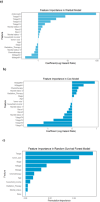Comparative study of machine learning and statistical survival models for enhancing cervical cancer prognosis and risk factor assessment using SEER data
- PMID: 39333298
- PMCID: PMC11437206
- DOI: 10.1038/s41598-024-72790-5
Comparative study of machine learning and statistical survival models for enhancing cervical cancer prognosis and risk factor assessment using SEER data
Abstract
Cervical cancer is a common malignant tumor of the female reproductive system and the leading cause of death among women worldwide. The survival prediction method can be used to effectively analyze the time to event, which is essential in any clinical study. This study aims to bridge the gap between traditional statistical methods and machine learning in survival analysis by revealing which techniques are most effective in predicting survival, with a particular emphasis on improving prediction accuracy and identifying key risk factors for cervical cancer. Women with cervical cancer diagnosed between 2013 and 2015 were included in our study using data from the Surveillance, Epidemiology, and End Results (SEER) database. Using this dataset, the study assesses the performance of Weibull, Cox proportional hazards models, and Random Survival Forests in terms of predictive accuracy and risk factor identification. The findings reveal that machine learning models, particularly Random Survival Forests (RSF), outperform traditional statistical methods in both predictive accuracy and the discernment of crucial prognostic factors, underscoring the advantages of machine learning in handling complex survival data. However, for a survival dataset with a small number of predictors, statistical models should be used first. The study finds that RSF models enhance survival analysis with more accurate predictions and insights into survival risk factors but highlights the need for larger datasets and further research on model interpretability and clinical applicability.
Keywords: Cervical cancer; Machine learning; Prognostic factors; Statistical methods; Survival analysis.
© 2024. The Author(s).
Conflict of interest statement
The authors declare no competing interests.
Figures




Similar articles
-
Data-driven survival modeling for breast cancer prognostics: A comparative study with machine learning and traditional survival modeling methods.PLoS One. 2025 Apr 22;20(4):e0318167. doi: 10.1371/journal.pone.0318167. eCollection 2025. PLoS One. 2025. PMID: 40262081 Free PMC article.
-
Deep learning models for predicting the survival of patients with hepatocellular carcinoma based on a surveillance, epidemiology, and end results (SEER) database analysis.Sci Rep. 2024 Jun 9;14(1):13232. doi: 10.1038/s41598-024-63531-9. Sci Rep. 2024. PMID: 38853169 Free PMC article.
-
Explainable machine learning predicts survival of retroperitoneal liposarcoma: A study based on the SEER database and external validation in China.Cancer Med. 2024 Jun;13(11):e7324. doi: 10.1002/cam4.7324. Cancer Med. 2024. PMID: 38847519 Free PMC article.
-
Cervical cancer survival prediction by machine learning algorithms: a systematic review.BMC Cancer. 2023 Apr 13;23(1):341. doi: 10.1186/s12885-023-10808-3. BMC Cancer. 2023. PMID: 37055741 Free PMC article.
-
Machine learning in predicting heart failure survival: a review of current models and future prospects.Heart Fail Rev. 2025 Mar;30(2):431-442. doi: 10.1007/s10741-024-10474-y. Epub 2024 Dec 10. Heart Fail Rev. 2025. PMID: 39656330 Review.
Cited by
-
Automated feature learning and survival prognostication in grade 4 glioma using supervised machine learning models.J Neurooncol. 2025 Oct;175(1):389-403. doi: 10.1007/s11060-025-05099-6. Epub 2025 Jun 16. J Neurooncol. 2025. PMID: 40522559
-
Explainable transformer-based deep survival analysis in childhood acute lymphoblastic leukemia.Comput Biol Med. 2025 Jun;191:110118. doi: 10.1016/j.compbiomed.2025.110118. Epub 2025 Apr 7. Comput Biol Med. 2025. PMID: 40198985
-
PTK6 mediated immune signatures revealed by single cell transcriptomic and multi omics big data analysis in cervical cancer.Discov Oncol. 2025 Aug 16;16(1):1566. doi: 10.1007/s12672-025-03365-7. Discov Oncol. 2025. PMID: 40818002 Free PMC article.
-
Development and validation of hybrid machine learning approach for predicting survival in patients with cervical cancer: a SEER-based population study.Front Oncol. 2025 Jun 18;15:1605378. doi: 10.3389/fonc.2025.1605378. eCollection 2025. Front Oncol. 2025. PMID: 40606977 Free PMC article.
-
Cervical cancer screening uptake and its associated factor in Sub-Sharan Africa: a machine learning approach.BMC Med Inform Decis Mak. 2025 May 26;25(1):197. doi: 10.1186/s12911-025-03039-y. BMC Med Inform Decis Mak. 2025. PMID: 40420148 Free PMC article.
References
-
- Sung, H. et al. Global cancer statistics 2020: GLOBOCAN estimates of incidence and mortality worldwide for 36 cancers in 185 countries. CA Cancer J. Clin.71, 209–249 (2021). - PubMed
-
- World Health Organization and others. Global Strategy to Accelerate the Elimination of Cervical Cancer as a Public Health Problem (World Health Organization, 2020).
-
- Siegel, R. L., Miller, K. D., Fuchs, H. E. & Jemal, A. Cancer statistics, 2022. CA Cancer J. Clin.72, 7–33 (2022). - PubMed
Publication types
MeSH terms
LinkOut - more resources
Full Text Sources
Medical
Miscellaneous

